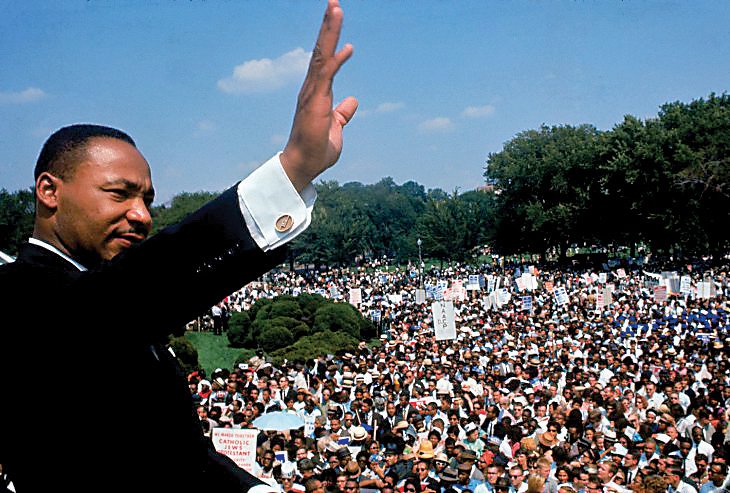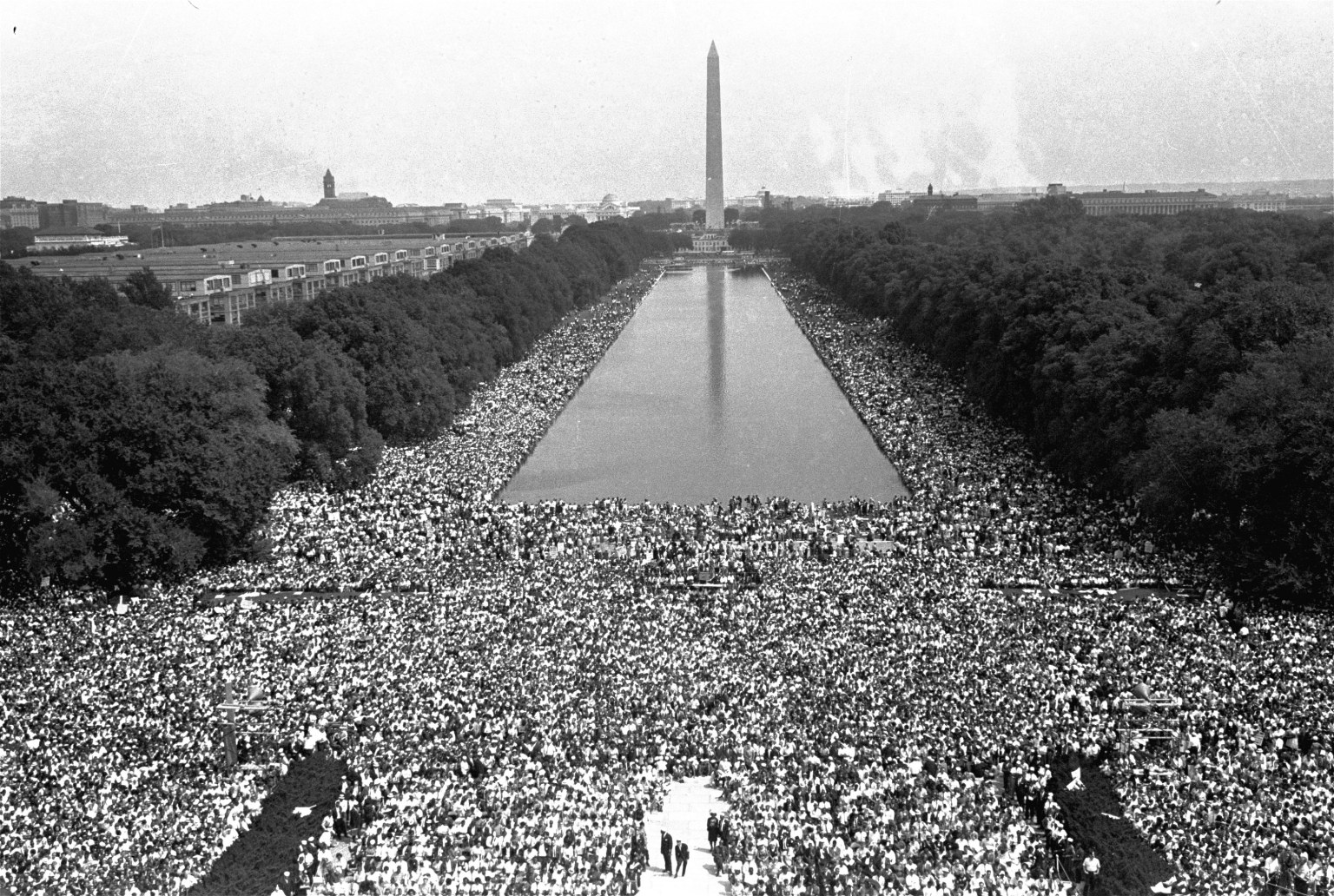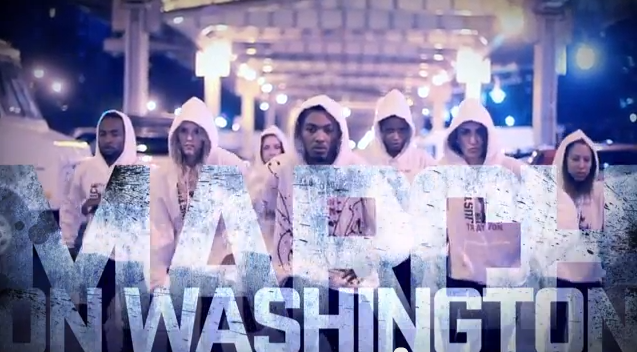
Fifty years ago, on August 28, 1963, the nation witnessed the largest march in its history. The March on Washington for Jobs and Freedom lives on in popular memory as the moment when Dr. Martin Luther King delivered his iconic “I Had A Dream” speech and called for racial integration and reconciliation in America. Most Americans today point to the emergence of a substantial black middle class and the election of the first African American President as evidence of our progress towards that goal.
We tend to overlook the other goal: of jobs that pay living wages and provide economic opportunity for all. Organizers of the March, as its title proclaimed, believed jobs and freedom were tightly bound: the purpose of the March was to address the “twin evils of discrimination and economic deprivation,” as stated in the July, 1963, “Call to Americans.”
According to University of Wisconsin historian William Jones in his new book, The March on Washington: Jobs, Freedom, and the Forgotten History of Civil Rights, the March organizers were black radicals whose objectives were no less than the fundamental social and economic transformation of American society.
A critical assessment of this event 50 years later reveals historical lessons relevant to contemporary movements for social and economic justice.
Rising Civil Rights Movement
The March on Washington occurred during the high tide of the American civil rights movement. In the early 1960s, sustained nonviolent direct action and civil disobedience spread across the south, including lunch counter sit-ins, freedom rides on interstate buses, and attempts to register black voters. The mass actions resulted in the jailing of thousands, widespread white violence against protestors, and extensive media coverage both nationally and internationally.
Democrat John F. Kennedy was elected by a slim margin in 1960 with support from Northern black voters, but he remained largely indifferent and reactive to the civil rights movement. However, after the brutal repression of civil rights marches in Birmingham, Alabama, in May, 1963, and Alabama Governor George Wallace’s defiance of federal authority when he refused to admit black students to the University of Alabama, Kennedy came down squarely on the side of the movement.
The President lobbied Birmingham’s political and corporate elite to desegregate public accommodations, and he sent Congress a moderate civil rights bill to end segregation in public accommodations and provide some protections for black voting rights in the south.
March on Washington Coalition
The march in August, 1963, was sponsored by a broad coalition of civil rights organizations, labor unions, and liberal religious denominations. The coalition came together on the basis of a shared understanding that the civil rights revolution could only prevail by a combination of a nonviolent mass movement from below and Congressional approval of comprehensive civil rights legislation.
The main organizers of the march were A. Phillip Randolph, President of the black Sleeping Car Porters Union, and Bayard Rustin, an advisor to Dr. King and an activist in campaigns for civil rights, disarmament, and human rights. Randolph and Rustin, anticipating American involvement in World War II, had planned the 1941 March on Washington, which was called off when President Franklin Roosevelt approved an executive order that barred racial discrimination by companies contracting with the federal government. Randolph would afterwards comment that minorities in a democracy could only bring about reform by “pressure, more pressure, and still more pressure through broad organized aggressive mass action.”
Randolph and Rustin were leaders in the Negro American Labor Council, an organization of black trade unionists who advocated for black labor rights, battled discrimination within organized labor, and pushed for full employment policies, including federal public works jobs for the unemployed. Both were committed democratic socialists, dedicated to forging an interracial coalition of civil rights and labor organizations to press for radical social and economic reform.
Jobs and Freedom
The organizers of the 1963 March on Washington intended to bring political pressure to bear on Congress to strengthen and approve Kennedy’s stalled civil rights legislation, and to build a movement for racial and economic justice that included: 1) a ban on employment discrimination in both the private and public sectors, enforced by a federal fair employment practices commission; 2) a massive federal jobs program at decent wages for unemployed workers displaced by automation and cyclical crisis; 3) a $2.00 an hour minimum wage that would lift working families out of poverty ($13.00 an hour in 2013 dollars), and that would cover previously excluded and predominantly minority domestic and agricultural workers.
More than a quarter of a million disciplined and peaceful marchers gathered on the mall stretching from the Lincoln to the Washington monument. Many arrived on the 2000 buses, 21 trains and 10 airplanes chartered by sponsors. The majority of participants were African Americans, but 40,000 trade unionists led by United Automobile Workers President Walter Reuther marched, and many were white.
“Civil Rights Plus Full Employment Equals Freedom,” and “Jobs for All At Decent Pay” were key slogans and demands displayed on official signs. These were demands that resonated with the American public.
In November, 1964, President Lyndon Johnson won in a landslide over Republican Barry Goldwater, reflecting growing support by white Northern and Western voters for civil rights and economic reform. Congress passed the Civil Rights Act of 1964, the Economic Opportunity Act of 1964 that launched the ‘War on Poverty,’ and the Voting Rights Act of 1965. These legislative achievements were a consequence of the March on Washington and pressure from below by the intensifying civil rights and economic justice movements.
Where Are We Now?
While much praised, what is the actual legacy of the 1963 March on Washington? One rock-solid result was passage and enforcement of laws prohibiting de jure discrimination in employment and other spheres of society. But the economic demands of the march were never achieved.
The polarization of wealth and incomes has reached the highest levels since the 1920s and upward mobility is at risk for all working class people. Between 1979-2007 the inflation-adjusted annual incomes of the top 1 percent of households increased by 240 percent, while the incomes of the middle fifth increased by only 19 percent. One quarter of white and half of black and Latino families are the working poor, with annual incomes of less than $44,700 in 2011. White unemployment is at 8 percent, the highest in three decades; Latino unemployment is 5 points higher, and black unemployment is nearly double that of whites.
Beyond that, a new type of second-class citizenship in America has emerged since the 1963 March on Washington. The nation’s immigration laws are broken and have effectively criminalized undocumented workers, who are denied basic civil and labor rights. A powerful movement has developed to demand amnesty and a pathway to citizenship for the nation’s 11 million undocumented immigrants--but the Republican far right is blocking comprehensive immigration reform.
Even the ‘rock solid’ legislative results are under attack. A conservative Supreme Court majority recently struck down key sections of the Voting Rights Act of 1965. The decision threatens to roll back the dramatic gains in minority voter registration and voter participation over the last forty years. With the power of the federal government to protect voting rights potentially curtailed, many states are set to implement new voting restrictions such as voter identification requirements, limits on early voting, and prohibiting same day registration intended to suppress voter participation and turnout by minority, youth, and low-income voters.
Finally, the tragic murder of Trayvon Martin raises troubling questions about racial profiling and violence deeply rooted in our society that is just two generations removed from systematic and brutal segregation.
A New Progressive Era
The significance of the March on Washington for today is that, as a multiracial coalition of civil rights, labor, and religious organizations is emerging again to demand jobs and freedom, we have the inspiration, but only partial achievements, to recall and ponder.
The coalition’s agenda includes massive federal spending to create good jobs for infrastructure, mass transit, energy conservation and clean energy, public education and public services. In addition, the federal minimum wage must be raised to at least $10.00 an hour and annually adjusted to inflation. Finally, Congress must enact comprehensive immigration reform and new legislation to protect minority-voting rights and LBGT rights.
The ‘new majority’ of youth, minority, gay and lesbian, women, labor, and immigrant voters who reelected President Obama last fall is the foundation of a new March on Washington coalition. A contemporary civil rights movement that incorporates immigrant rights, climate justice, reproductive rights, and marriage equality may converge with a revitalized labor movement committed to organizing low-wage, youth, and immigrant workers--to once again bring pressure from below on the President, Congress, and the courts to usher in a new era of progressive reform.
Martin Bennett is Instructor Emeritus of History at Santa Rosa Junior College, Co-Chair of the Living Wage Coalition of Sonoma County/Jobs with Justice Organizing Committee, and a research and policy analyst for UNITE HERE Local 2850. Fred Glass is Communications Director for the California Federation of Teachers and an adjunct instructor in the Labor and Community Studies Department at City College of San Francisco.
3 WAYS TO SHOW YOUR SUPPORT
- Log in to post comments




















